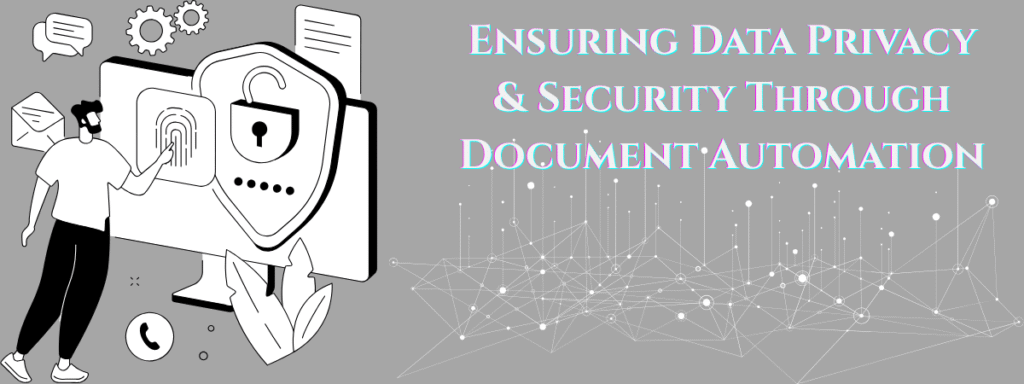Why Document Automation Is the Key to Effortless GDPR Compliance

GDPR compliance came into the picture in May 2018. Since then, companies look at it like a bane rather than the boon that it is for organizations and their clients. The general assumption is that GDPR is like a complex process, and even a small mistake can have unimaginable consequences. The looming fear of audits and fines is obvious if you’re still insisting on manual processes.
Did you know? By January 2025, the cumulative total of GDPR fines has reached approximately €5.88 billion, highlighting the continuous enforcement of data protection laws and the rising financial repercussions for non-compliance.
Big tech companies have been the primary target, but regulatory authorities are expanding their focus on various industries, including finance, healthcare, and energy. All industries where millions of documents are exchanging hands on a daily basis. Fortunately, document automation has risen to serve as the safety net every modern organization needs.
Key Takeaway:
- Regulatory enforcers are expanding their focus into various industries, as seen by the growing fines.
- Manual compliance is risky and slow; automation software and tools can be used to reduce errors, save time and money, and build trust amongst clients.
- Document automation doesn’t just help to comply with GDPR, but also offers many strategic advantages for any business.
- Privacy by Design and automation make compliance proactive, building customer trust and business reputation.
Want to help organizations streamline operations, avoid costly fines, and build lasting trust with customers. Download our whitepaper on GDPR to find out more.
The Compliance Challenge
Your company’s data requires countless hours spent logging consent, updating policies, mapping risky data flows, and responding to subject access requests. Manual GDPR compliance is no walk in the park. These documents could be anything related to personal information or Personally Identifiable Information (PII). And just because it is a European law, it doesn’t mean it doesn’t apply elsewhere. Even if you are based out of Europe, as long as you have European customers, you will have to adhere to GDPR.
Of course, doing this manually is not easy at all; there are too many risks involved: it is time-consuming and prone to human error. Most importantly, the question remains–how will you manage to scale this as your business grows?
Document automation ensures compliance through workflows, such as automating data capture, workflow routing, and compliance logging, and more. Through this, companies create a guardrail system that protects every document that enters or leaves the business. The goal is to process every document with the same security, accuracy, and transparency that GDPR requires.
Before you decide on whether your organization needs document automation, ask yourself these questions to get a clear picture of your needs.
● Is consent being tracked and enforced on every document that involves personal data?
● Can you look up documents quickly, and if there are multiple copies or the same document, would you be able to see the latest versions?
● Who has access to the documents? Can you track who has viewed or edited documents?
● Can any data breach be detected and flagged as soon as the incident occurs?
● Are you deleting the data as per the retention policies?
● Are you responding to Data Subject Requests (DSR) regarding personal data?
If the answer to even one of these questions is no, it is time to consider a document automation system that will help you ease the supposed burden of GDPR.
Want to learn more about GDPR? Download our whitepaper to know everything about document automation’s impact on GDPR.
How Document Automation Streamlines GDPR Compliance
Automated document generation isn’t just about saving time or money; it’s what builds and maintains the trust of your clients or customers.
An automated workflow is a well-synchronized tool, where every aspect, including data capture, approvals, retention, and consent management, works in tandem to comply with GDPR stringently. The three points below are the main components that any document automation system should consist of for data privacy and security:
Centralized Data Inventory: Automated tools that scan and map all personal data, giving businesses a comprehensive, real-time understanding of what data they hold and how it flows through their systems. This is the foundation that aids in consent validation, data access requests, and risk assessments.
Automated Consent and Rights Management: Is it feasible to track permissions manually on spreadsheets? With the sheer amount of requests, platforms or software must be used to capture, store, and update consent in real time. This ensures any DSR requests can be answered, and changes and updates will be quick. Respecting user rights is one of the principles of GDPR.
End-to-End Security Controls: Encryption, access controls, and breach detection alerts are all crucial capabilities to continuously monitor vulnerabilities. As soon as a risk appears, only the implementation of these security protocols can ensure that response plans will be executed within the critical 72-hour window required by GDPR.
Strategic Advantages of Document Automation
Organizations that leverage automation tools have obvious advantages, not just for GDPR compliance, but they also reduce the overall costs and human errors. Businesses also emphasize consistency, accuracy, and organizational agility. Here’s what they gain:
Operational Efficiency: Manual compliance tasks are obviously reduced, freeing teams to focus on what matters–the clients.
Scalability: The goal of any business is to grow, and when it does, compliance scales with it when you have automation on your side.
Error Reduction and Risk Mitigation: Humans are bound to make errors, but machines will work around the clock to monitor and catch violations early, lowering the risk of fines and preserving organizational trust and reputation.
Competitive Differentiation: Today’s customers prioritize data privacy and security, willing to pay extra for transparent, secure data practices. Compliance has now become a valuable asset for any company.
Proactive Approach: The biggest benefit of document automation is that it is proactive instead of reactive. Frequent checks and error reduction make it easier to ensure compliance.
The premise of all this is that the document automation software is designed with GDPR compliance in mind and has all the capabilities to prioritize security without compromising on operational efficiency. This aspect is highlighted in Privacy by Design, a fundamental principle of the framework, detailed in Article 15 of the GDPR.
Real-World Example of Document Automation in Action
Let’s look at an industry where GDPR must be stringently followed–the insurance industry. In Insurance, several documents, such as policy notifications, renewals, claims, and so much more, are processed daily. Manual checks for consent, data minimization, and retention schedules can be overwhelming. Document automation solutions can make the whole process smoother, tracking every policy, encrypting sensitive fields, automatically deleting expired information, and updating the latest data. This is not all; it also involves meeting regulatory requirements and establishing a comprehensive audit trail for every transaction.
The future of Data Privacy and Security
Automation isn’t just easing your GDPR burdens, but it is and will continue to be the backbone of future-proofed data privacy. As regulations evolve and customer expectations rise, organizations that have implemented document automation are positioned to transform themselves in this compliance-first era, from a mandatory check into a strategic pillar of business trust among clients.
Interested in mapping your GDPR journey confidently? Download our comprehensive whitepaper to equip your business with expert frameworks built for today’s digital-first world.
FAQs
GDPR (General Data Protection Regulation) is the European Union’s data privacy law. It applies to any company processing the data of European residents, regardless of where the company is based. This means even organizations outside Europe must comply if they handle EU customer data.
Manual compliance depends on human tracking, policy updates, and responses to data requests. This increases the likelihood of errors, omissions, and delays—which can result in fines and a loss of customer trust.
Document automation enables secure, consistent, and trackable handling of documents. It automates consent management, data capture, workflow routing, compliance logging, and breach alerts, reducing manual labor while strengthening security.
- Centralized data inventory for real-time tracking
- Automated consent and rights management
- End-to-end security controls for encryption and access
Heavily regulated sectors such as finance, healthcare, energy, and insurance, where sensitive personal data is handled, experience the greatest benefits from automation solutions.
‘Privacy by Design’ mandates that systems and processes be built to prioritize security from the outset. Automation platforms integrate these safeguards into document workflows, ensuring compliance and protecting user data.
Top Invoice Generator(s)
Creating professional invoices is crucial for any business, whether you’re a freelancer, small
Confirmation Email Design, Examples, and Best Practices
As a consumer, have you ever made a purchase or signed up for a service, only to wonder if your acti
Predicting the future in the CCM space
Customer communications management (CCM) is an industry that has been around for a long time. Compan




